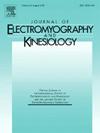The effects of plantar surface stimulation on neuromuscular responses during standing balance and gait in healthy and clinical populations: A systematic review
IF 2
4区 医学
Q3 NEUROSCIENCES
引用次数: 0
Abstract
Enhanced sensory input applied to the plantar surface of the feet, through innovative sensory-stimulating footwear devices, has the potential to improve standing balance and gait. However, the underlying mechanisms by which sensory-stimulating footwear devices bring about their effects on balance and gait remain unclear: changes in neuromuscular control are one possible option. This systematic review aimed to synthesize the effects of enhanced plantar surface stimulation, via footwear, shoe inserts, or floor surfaces, on neuromuscular responses during standing balance and walking gait in healthy and clinical populations. Four databases were selected to identify studies of plantar stimulation devices designed to alter neuromuscular responses during balance or gait. 2773 articles were screened for eligibility based on title and abstract. Thereafter, 37 articles underwent full text review, of which 17 articles were included in the review. The evidence that enhanced plantar sensory stimulation alters muscle activity during standing balance is limited, and during gait is moderate. The effects of sensory-stimulating footwear devices also appear to be dependent on factors such as the target population, the location of the sensory stimuli under the foot, or the complexity of the postural or walking task.
足底表面刺激对健康和临床人群站立平衡和步态时神经肌肉反应的影响:系统综述
通过创新的感觉刺激鞋类设备,增强的感觉输入应用于脚底表面,有可能改善站立平衡和步态。然而,感觉刺激鞋类设备对平衡和步态影响的潜在机制尚不清楚:神经肌肉控制的改变是一种可能的选择。本系统综述旨在综合通过鞋类、鞋垫或地板表面增强足底表面刺激对健康和临床人群站立平衡和步行步态时神经肌肉反应的影响。选择了四个数据库来确定设计用于改变平衡或步态时神经肌肉反应的足底刺激装置的研究。根据标题和摘要筛选2773篇文章。此后,对37篇文章进行了全文审查,其中17篇文章被纳入审查。加强足底感觉刺激改变站立平衡时肌肉活动的证据是有限的,在步态时是中等的。感觉刺激鞋类设备的效果似乎也取决于目标人群、脚下感觉刺激的位置、姿势或行走任务的复杂性等因素。
本文章由计算机程序翻译,如有差异,请以英文原文为准。
求助全文
约1分钟内获得全文
求助全文
来源期刊
CiteScore
4.70
自引率
8.00%
发文量
70
审稿时长
74 days
期刊介绍:
Journal of Electromyography & Kinesiology is the primary source for outstanding original articles on the study of human movement from muscle contraction via its motor units and sensory system to integrated motion through mechanical and electrical detection techniques.
As the official publication of the International Society of Electrophysiology and Kinesiology, the journal is dedicated to publishing the best work in all areas of electromyography and kinesiology, including: control of movement, muscle fatigue, muscle and nerve properties, joint biomechanics and electrical stimulation. Applications in rehabilitation, sports & exercise, motion analysis, ergonomics, alternative & complimentary medicine, measures of human performance and technical articles on electromyographic signal processing are welcome.

 求助内容:
求助内容: 应助结果提醒方式:
应助结果提醒方式:


